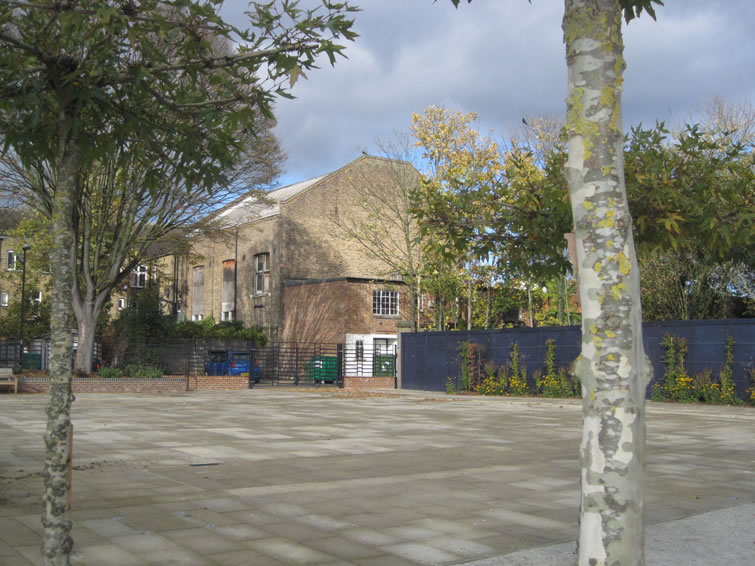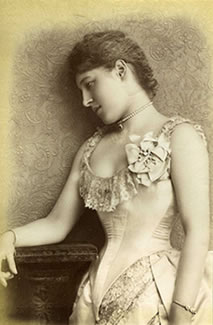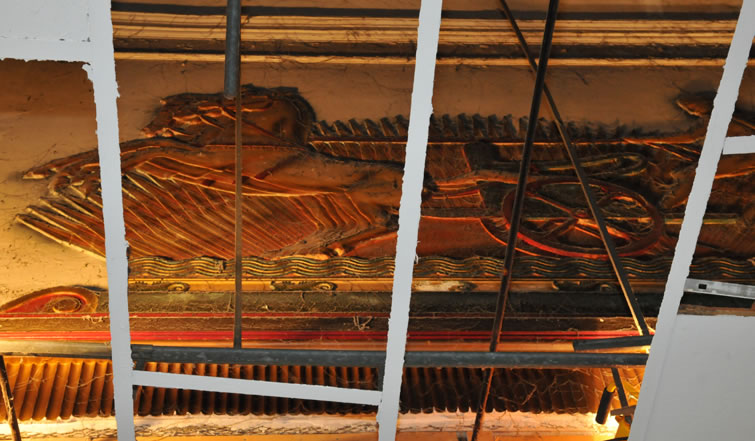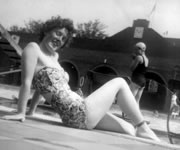Queen's Hall
Queen's Hall is at the rear of 9 King Street and can be seen to the best advantage from the Diamond Jubilee Gardens (on the site of the old pool site).

Between 1882 and 1907 the building was used as municipal offices, a public reading room and a library.
Queen's Hall forms the remnant of a building that formerly housed Twickenham Town Hall and the Public Library. Construction, privately financed by the well-known local property developer Charles Freake, was started in 1876 and completed the following year. Earlier venues to serve the purposes of a town hall had proved less than satisfactory: the Twickenham Lecture Hall in Heath Road (built 1864) survived only three years, and the converted Montpelier Proprietary Chapel was regarded as not in a central enough location.
Originally, the Town Hall was no. 8 King street (Goad map 1907), but at that time buildings were numbered consecutively from the Water Lane end, instead of, as later (and now), the South side having odd numbers, the North side evens. The building now fronting the Queen's Hall (Bu'sen – see below) is no. 9 King St.
The opening of the Town Hall was a much anticipated event, as there was a great perceived desire locally for a good hall for public meetings. It was, however, rather low key, being described as “the semi-official inauguration”.
The Town Hall was originally intended as purpose-built offices for the Local Board (formed in 1868), and Mr Freake allowed the Board free use. In 1896 the successor to the Board, the Urban District Council, leased the building. The small rooms in the front were converted in 1882/3 to the Library, which subsequently moved to Garfield Road in 1902. The auditorium at the rear, The Queen's Hall, was used for meetings, early film shows and amateur dramatics. The first meeting there was in July 1877, when there was a gathering of the Provincial Grand Mark Lodge of Masons. Usage of the Hall seems to have got off to a slow start, as the local paper in January 1878 bemoaned the lack of use, but this changed after a short while (see below).
The Queen's Hall was used for concerts, and there is evidence that, among many others, the violinist André Mangeot and the trumpeter Thomas Harper performed there (www.concertprogrammes.org.uk). Trawling through the 1888 Richmond & Twickenham Times and the 1889 Thames Valley Times indicates the wide variety of functions that took place in the Hall; besides the weekly meeting of the Local Board, these included: The Nubian Minstrels, The Police Minstrels, The Ebony Minstrels, “Penny Entertainments”, the AGM of The Twickenham Horticultural Society, The Twickenham Choral Society, Frank Figg's Concerts, held at Saturday evenings, a “Bazaar of Useful and Fancy Articles”, the Twickenham and District Hearth and Home Benefit Building Society, various amateur dramatic performances, the Twickenham Glee and Madrigal Society, the Church of England Temperance Society (of which Mrs Twining was President), the ball of Twickenham Rowing Club, the Thames Valley Orchestral Society, the Independent Order of Good Templars and the Twickenham Habitation of the Primrose League.
Special mention in 1888 must go to the celebration of Alexander Pope's bicentenary: following several meetings there of the Pope Commemoration Committee, the Hall was used as a special Loan Museum. The event was celebrated by a special supplement, with illustrations, of the local newspaper (July). In 1889 there was much excitement at the visit of the Comtesse de Paris to attend a Bazaar and Sale of Work in the Hall, after which there was a demonstration of Edison's phonograph.

The Queen's Hall is probably best remembered for the stage debut of Lillie Langtry, the Prince of Wales' former mistress. This took place on November 19 1881, on an evening described in the local Press as a “Grand Dramatic Performance – a brilliant success”. Many notable dignitaries attended, including members of the Twining family (Dial House), Mr and Mrs GG MacKintosh (Richmond House), Mr H Labouchere MP (Popes Villa) and Oscar Wilde. The event was to raise money for St John's Hospital, and was under the patronage of The Duchess of Tek; it consisted of two plays performed by amateurs, the second of which, a comedietta entitled A Fair Encounter, featured Mrs Labouchere and, in her first acting role, the latter's protégée, Lillie Langtry. She received rave reviews in the local Press as well as in The World and Truth, although most of the plaudits were reserved for the acting skills of Mrs Labouchere.[author's note: the adulatory tone is hardly surprising, as the latter two journals were wholly controlled by Mr Labouchere]. It is remarkable that it was only one month after this that Lillie made her debut as a professional actress in London.
The Town Hall and Queens Hall continued to be used in much the same way until the mid-1920s, when it became apparent that the existing building was too small. In 1922 the last inhabitant of Richmond House (that adjoined the Town Hall), Mrs MacKintosh, died, and the house was put up for auction. It appeared to some that the ideal solution would be to convert Richmond House into the new town hall, so the Board resolved to buy it; however, a Richmond Councillor and entrepreneur, Joseph Mears, outbid Twickenham. There then ensued much debate as to whether Richmond House or York House (that had also just come onto the market) would be more suitable as a town hall. Eventually, the York House option was taken and Richmond House (somewhat grudgingly) bought from Mr Mears and demolished, later to become the site of Twickenham Swimming Baths. The front part of the Town Hall was demolished in 1926 as part of the widening of King Street, when Twickenham had been given Borough status, but Queens Hall remained intact.
Kelly's Directory for 1926 and 1927 still lists no.8 King Street (South side) as being the Town Hall for Twickenham Urban District Council, but in 1928 it is referred to as the Old Town Hall, and it is unoccupied. King Street was renumbered in 1929, no. 8 becoming no.9. In 1930 the Council sold the Old Town Hall + Queens Hall site and other neighbouring properties to D.Morris and Sons Ltd., who let out premises on 25 year leases. It becomes clear that some property remained in front of the Hall after the demolition, as there are records of occupation of no. 9 King street (and sometimes also no. 9a) after 1931. The Hall became a venue for dance: between 1932 and 1939 there is a “dance hall proprietor” (R.Palmer) living at no. 9, and in 1940 a company called Danse-de-Luxe Ltd took over. However, the latter went into voluntary liquidation in 1942 (London Gazette).
Bushy Park became the headquarters (named Camp Griffiss) for the US Air Force during World War II, and at the time of the run-up to the D Day invasion of France (6 June 1944) there were also large number of American soldiers in Richmond and neighbouring districts, as the Supreme Headquarters, Allied Expeditionary Force (SHAEF), with General Dwight Eisenhower in command, was also based there. During this period there were dances held at the Hall for the benefit of the GIs.
In 1946 the Hall was listed in the Rate Book as “derelict”, and it does not appear to have been used again until 1954 (it was unoccupied in 1953), when The Court School of Dancing moved in. This was a large organization with at least a dozen other branches, whose Principal was Courtenay Castle, author of books such as Learn to Dance (1965) and Better Dancing (1967). “C.Castle of Reigate” is noted as the owner in the 1956 Rate Book, so he must have bought the freehold. The School offered nightly ballroom classes; single lessons five shillings or a course of five for one guinea (£1.05). The School evidently did well, eventually moving out in 1985. From that time until the present the lease of the Queens Hall has been held by the Bu'sen Martial Arts School; this thriving organization (www.bu-sen.co.uk) is run by Frank Perry, and teaches karate, judo, ju-jitsu and tai chi, and has a weights gym.
At some stage after 1985 the freehold of the Hall, as well as the rest of the South side of King Street (nos 1 – 33), was bought by the property arm of Dawnay, Day (who in 2001 submitted a planning application to develop the derelict old Pool site). However, that Company experienced financial problems in 2008, and their main creditor, Norwich Union (now Aviva) sold the site in 2009 to Omaha Nominees Ltd. It is now managed by F&C REIT.
Queen's Hall is a tall rectangular brick building with a double pitched roof; it is simple but impressive. Two storey extensions have been added to the elevation at the back of the Hall.
 The entrance from King Street has the words “Queen's Hall” on the tiled floor. A fully working Victorian air ventilation system, behind a decorative metal grille, runs around the hall and foyer areas. The original stage is at the side of the hall and the hall has a sprung floor.
The entrance from King Street has the words “Queen's Hall” on the tiled floor. A fully working Victorian air ventilation system, behind a decorative metal grille, runs around the hall and foyer areas. The original stage is at the side of the hall and the hall has a sprung floor.
A false ceiling in the main hall hides a decorative painted plaster motif of a horse-drawn chariot and chandeliers hang from the high ceiling.



